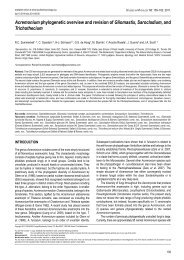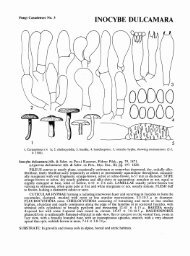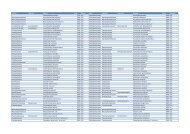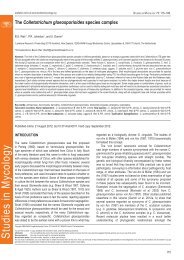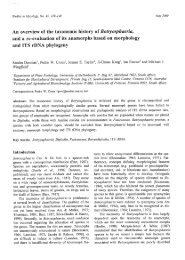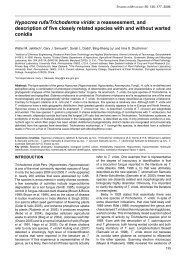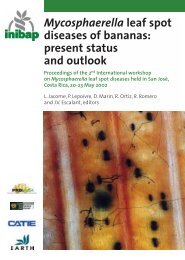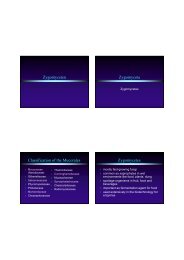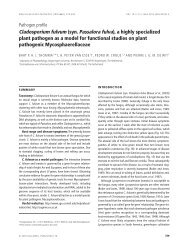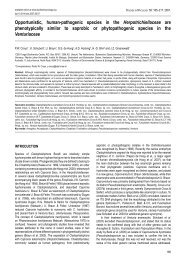Molecular Diagnostics for the Sigatoka Disease Complex of ... - CBS
Molecular Diagnostics for the Sigatoka Disease Complex of ... - CBS
Molecular Diagnostics for the Sigatoka Disease Complex of ... - CBS
You also want an ePaper? Increase the reach of your titles
YUMPU automatically turns print PDFs into web optimized ePapers that Google loves.
1112 PHYTOPATHOLOGY<br />
Techniques<br />
<strong>Molecular</strong> <strong>Diagnostics</strong> <strong>for</strong> <strong>the</strong> <strong>Sigatoka</strong> <strong>Disease</strong> <strong>Complex</strong> <strong>of</strong> Banana<br />
Mahdi Arzanlou, Edwin C. A. Abeln, Gert H. J. Kema, Cees Waalwijk, Jean Carlier,<br />
Ineke de Vries, Mauricio Guzmán, and Pedro W. Crous<br />
First and eighth authors: Laboratory <strong>of</strong> Phytopathology, Wageningen University, Binnenhaven 5, 6709 PD Wageningen, The Ne<strong>the</strong>rlands;<br />
first, second, and eighth authors: <strong>CBS</strong> Fungal Biodiversity Centre, Uppsalalaan 8, 3584 CT Utrecht, The Ne<strong>the</strong>rlands; third, fourth, and<br />
sixth authors: Plant Research International BV, P.O. Box 16, 6700 AA Wageningen, The Ne<strong>the</strong>rlands; fifth author: Centre de Coopération<br />
Internationale en Recherche Agronomique pour le Développement (CIRAD), UMR-BGPI, TA41/K, Campus International de Baillarguet<br />
34398 Montpellier Cedex 5, France; and seventh author: CORBANA S.A., P.O. Box 6504-1000 San José, Costa Rica.<br />
Accepted <strong>for</strong> publication 21 March 2007.<br />
Arzanlou, M., Abeln, E. C. A., Kema G. H. J., Waalwijk, C., Carlier, J., de<br />
Vries, I., Guzmán, M., and Crous, P. W. 2007. <strong>Molecular</strong> diagnostics <strong>for</strong><br />
<strong>the</strong> <strong>Sigatoka</strong> disease complex <strong>of</strong> banana. Phytopathology 97:1112-1118.<br />
The <strong>Sigatoka</strong> disease complex <strong>of</strong> banana involves three related ascomycetous<br />
fungi, Mycosphaerella fijiensis, M. musicola, and M. eumusae.<br />
The exact distribution <strong>of</strong> <strong>the</strong>se three species and <strong>the</strong>ir disease epidemiology<br />
remain unclear, because <strong>the</strong>ir symptoms and life cycles are ra<strong>the</strong>r<br />
similar. <strong>Disease</strong> diagnosis in <strong>the</strong> Mycosphaerella complex <strong>of</strong> banana is<br />
based on <strong>the</strong> presence <strong>of</strong> host symptoms and fungal fruiting structures,<br />
which hamper preventive management strategies. In <strong>the</strong> present study, we<br />
have developed rapid and robust species-specific molecular-based diag-<br />
Banana and plantain (Musa spp.) are among <strong>the</strong> world’s most<br />
important staple food crops, ranking fourth after wheat, rice, and<br />
corn, with exported banana valued at US$ 4.5 to 5 billion per year<br />
during 1998 to 2000 (18,19). However, banana plants are prone to<br />
a variety <strong>of</strong> devastating diseases, including Fusarium wilt, caused<br />
by F. oxysporum f. sp. cubense; banana bunchy top virus; and<br />
Mycosphaerella spp.-associated leaf spot diseases. Although<br />
several species <strong>of</strong> Mycosphaerella have been described from<br />
banana (6–8,15), three species, namely Mycosphaerella fijiensis<br />
(causal agent <strong>of</strong> black leaf streak disease), M. musicola (causal<br />
agent <strong>of</strong> yellow <strong>Sigatoka</strong> disease), and M. eumusae (causal agent<br />
<strong>of</strong> eumusae leaf spot disease), cause major economic losses<br />
(9,19). These diseases are serious threats <strong>for</strong> banana production<br />
worldwide because <strong>the</strong>y reduce photosyn<strong>the</strong>tic capacity <strong>of</strong> plants<br />
through necrotic leaf lesions, which result in reduced crop yield<br />
and fruit quality. Yellow <strong>Sigatoka</strong> first was described on banana in<br />
Java in 1902, and became a serious global disease epidemic<br />
during <strong>the</strong> next 40 years. The disease was especially severe in <strong>the</strong><br />
<strong>Sigatoka</strong> Valley in Fiji, where banana plants were sprayed intensively<br />
with fungicides to control disease; it also was here that<br />
black leaf streak disease first appeared in 1963 (15). Black leaf<br />
streak predominantly occurs in lowlands, but at altitudes <strong>of</strong><br />
>1,500 m in Colombia and Costa Rica both pathogens are equally<br />
severe (18). M. fijiensis is considered a quarantine organism in<br />
many banana-producing areas and continues to occupy new<br />
ecological niches, although it is presently still unknown from<br />
many countries in Latin America and <strong>the</strong> Caribbean region. More<br />
recently, it has been reported in Trinidad (10), and we have<br />
Corresponding author: G. H. J. Kema; E-mail address: gert.kema@wur.nl<br />
doi:10.1094/ PHYTO-97-9-1112<br />
© 2007 The American Phytopathological Society<br />
ABSTRACT<br />
nostic tools <strong>for</strong> detection and quantification <strong>of</strong> M. fijiensis, M. musicola,<br />
and M. eumusae. Conventional species-specific polymerase chain reaction<br />
(PCR) primers were developed based on <strong>the</strong> actin gene that detected<br />
DNA at as little as 100, 1, and 10 pg/µl from M. fijiensis, M. musicola,<br />
and M. eumusae, respectively. Fur<strong>the</strong>rmore, TaqMan real-time quantitative<br />
PCR assays were developed based on <strong>the</strong> β-tubulin gene and detected<br />
quantities <strong>of</strong> DNA as low as 1 pg/µl <strong>for</strong> each Mycosphaerella sp. from<br />
pure cultures and DNA at 1.6 pg/µl per milligram <strong>of</strong> dry leaf tissue <strong>for</strong><br />
M. fijiensis that was validated using naturally infected banana leaves.<br />
Additional keywords: Mycosphaerella spp., <strong>Sigatoka</strong> complex.<br />
confirmed its presence in Grenada in <strong>the</strong> Caribbean region<br />
(J. Carlier and M. Arzanlou, unpublished data). Yellow <strong>Sigatoka</strong><br />
normally is observed under cooler conditions than black leaf<br />
streak disease, and ascospore and conidial germ tubes <strong>of</strong><br />
M. musicola grow faster at cooler conditions than those <strong>of</strong><br />
M. fijiensis (14,18). Yellow <strong>Sigatoka</strong> mostly has been replaced by<br />
black leaf streak disease in Central America and <strong>the</strong> coastal areas<br />
<strong>of</strong> <strong>the</strong> Caribbean, but it remains a considerable problem in<br />
subtropical regions (2,14,18). M. fijiensis is more aggressive than<br />
M. musicola, and causes premature fruit ripening with losses <strong>of</strong><br />
33 to 76% (15,18,22).<br />
In <strong>the</strong> mid-1990s, a third Mycosphaerella sp., M. eumusae, was<br />
recognized as a new constituent <strong>of</strong> <strong>the</strong> <strong>Sigatoka</strong> complex <strong>of</strong><br />
banana (4,9). Presently, M. eumusae is known from Sou<strong>the</strong>ast<br />
Asia and parts <strong>of</strong> Africa, where it affects cultivars that are highly<br />
resistant to both M. musicola and M. fijiensis (15). The chronology<br />
<strong>of</strong> disease records around <strong>the</strong> world suggests that Sou<strong>the</strong>ast<br />
Asia is <strong>the</strong> center <strong>of</strong> origin <strong>for</strong> all <strong>the</strong>se three species (15,20). Asia<br />
is <strong>the</strong> centre <strong>of</strong> diversity <strong>of</strong> banana as well, where earliest domestication<br />
<strong>of</strong> edible banana took place and many wild banana<br />
cultivars still grow naturally in <strong>the</strong> <strong>for</strong>ests (15). Even though<br />
M. fijiensis has been present in Sou<strong>the</strong>ast Asia <strong>for</strong> a long time, it<br />
has not become <strong>the</strong> dominant pathogen over M. musicola in this<br />
region. This might be due to competition among <strong>the</strong> three species<br />
or to <strong>the</strong> existence <strong>of</strong> different host populations in this region,<br />
which could lead to co-evolution <strong>of</strong> each species with different<br />
host populations in different areas (3,15,20). However, <strong>the</strong> exact<br />
distribution <strong>of</strong> <strong>the</strong> three species in this region remains unclear,<br />
because <strong>the</strong>ir symptoms are ra<strong>the</strong>r similar (9,15).<br />
A component <strong>of</strong> successful plant disease management is early<br />
detection <strong>of</strong> <strong>the</strong> pathogens that cause <strong>the</strong> <strong>Sigatoka</strong> disease<br />
complex, encompassing eradication and chemical and quarantine<br />
management strategies. Traditionally, diagnosis <strong>of</strong> <strong>the</strong> constituent<br />
species in <strong>the</strong> <strong>Sigatoka</strong> complex was based on disease symptoms,
which have limited diagnostic value due to <strong>the</strong>ir similarity, and<br />
<strong>the</strong> long latent period that varies from 14 to 35 days, depending<br />
on wea<strong>the</strong>r conditions and cultivar (2,18). Species <strong>of</strong> Mycosphaerella<br />
are distinguished by morphological characteristics that<br />
require expertise to distinguish, including ascospore morphology,<br />
germination patterns, and minute differences in <strong>the</strong> morphology<br />
<strong>of</strong> <strong>the</strong>ir anamorphs (5,8). Fur<strong>the</strong>rmore, traditional diagnosis is<br />
time consuming and inappropriate <strong>for</strong> eradication and quarantine<br />
management strategies.<br />
In recent years, conventional polymerase chain reaction (PCR)based<br />
techniques have emerged as robust tools <strong>for</strong> diagnosis and<br />
detection <strong>of</strong> phytopathogenic fungi and have contributed greatly<br />
to plant disease management (12,13,17,25). However, postamplification<br />
procedures and <strong>the</strong> presence <strong>of</strong> chemical elements<br />
in plant extracts still prevent <strong>the</strong> large-scale application <strong>of</strong> diagnostic<br />
PCR in plant pathology. Moreover, in conventional PCR,<br />
<strong>the</strong> amplification efficiency is not consistent during all PCR<br />
cycles, and remains unreliable <strong>for</strong> quantitative analysis (11,17).<br />
Real-time PCR alleviates <strong>the</strong>se difficulties because it combines<br />
<strong>the</strong>rmal cycling with online fluorescent detection <strong>of</strong> amplicons.<br />
Unlike <strong>the</strong> end-point PCR, accumulation <strong>of</strong> amplicons is<br />
monitored during all PCR cycles. In real-time PCR reactions, <strong>the</strong><br />
specific cycle number at which a statistically significant increase<br />
in fluorescence can be detected is defined as <strong>the</strong> threshold cycle<br />
(Ct). By definition, <strong>the</strong> C t value is inversely proportional to <strong>the</strong> log<br />
value <strong>of</strong> <strong>the</strong> initial template DNA quantity. There<strong>for</strong>e, real-time<br />
technology is widely used to detect and quantify DNA from plant<br />
pathogens (17,25). This technique enables DNA quantification at<br />
very low concentrations (pg/ml), and has been applied in quantitative<br />
detection <strong>of</strong> plant pathogens, biological control agents,<br />
plant–microbe interaction experiments (23,24), and monitoring<br />
studies (11,21).<br />
The aim <strong>of</strong> <strong>the</strong> present study was to develop and optimize<br />
molecular-based detection and quantification tools <strong>for</strong> M. fijiensis,<br />
M. musicola, and M. eumusae, <strong>the</strong> primary species <strong>of</strong> <strong>the</strong><br />
<strong>Sigatoka</strong> complex <strong>of</strong> banana, to fur<strong>the</strong>r facilitate ecological and<br />
epidemiological studies <strong>of</strong> this diseases complex.<br />
A future goal would be to implement <strong>the</strong>se tools in decision<br />
support systems that will be established <strong>for</strong> disease management.<br />
MATERIALS AND METHODS<br />
Genomic DNA <strong>for</strong> PCR analysis. The Mycosphaerella strains<br />
as well as fungal species commonly occurring on banana leaves<br />
that were used to test primer and probe specificity are listed in<br />
Table 1. Genomic DNA was extracted from axenic cultures grown<br />
on agar plates using <strong>the</strong> PureGene kit (Gentra Systems Inc.,<br />
Minneapolis, MN), whereas <strong>the</strong> DNeasy Plant Mini Kit (Qiagen,<br />
Germany) was used to isolate DNA from uninfected banana<br />
leaves as well as banana leaves naturally infected with M. fijiensis,<br />
M. musicola, or M. eumusae. Genomic DNA was used to test<br />
<strong>for</strong> possible cross reactions and to verify <strong>the</strong> specificity and<br />
efficacy <strong>of</strong> <strong>the</strong> real-time PCR primers and probes.<br />
Primers <strong>for</strong> qualitative PCR. A generally applicable primer<br />
pair ACTF/ACTR (Table 2; expected amplicon size 820 bp) was<br />
designed and used to generate actin sequences from different<br />
Mycosphaerella spp. and o<strong>the</strong>r fungi commonly causing leaf<br />
spots on banana. Amplification reactions were per<strong>for</strong>med with <strong>the</strong><br />
ACTF/ACTR primer pair in a total reaction volume <strong>of</strong> 25 µl,<br />
which was composed <strong>of</strong> 1× PCR buffer (Applied Biosystems,<br />
Foster City, CA), 1.5 mM MgCl2, 60 µM dNTPs, 0.2 µM ACTF<br />
and ACTR primers, 1.5 U <strong>of</strong> Taq DNA polymerase (Roche<br />
<strong>Diagnostics</strong>, Indianapolis, IN), and 1 ng <strong>of</strong> genomic DNA. PCR<br />
cycle conditions were 5 min <strong>of</strong> 95°C; followed by 36 cycles <strong>of</strong><br />
94°C <strong>for</strong> 30 s, 60°C <strong>for</strong> 30 s, and 72°C <strong>for</strong> 60 s; and a final<br />
elongation at 72°C <strong>for</strong> 7 min. PCR amplicons were sequenced<br />
using Amersham Dye chemistry (Amersham Biosciences).<br />
Primers <strong>for</strong> conventional PCR were designed based on sequence<br />
alignment <strong>of</strong> <strong>the</strong> actin gene <strong>for</strong> <strong>the</strong> 17 Mycosphaerella spp.<br />
associated with <strong>the</strong> <strong>Sigatoka</strong> leaf spot disease complex <strong>of</strong> banana:<br />
6 known species (Table 1) and 11 undescribed Mycosphaerella<br />
spp. (M. Arzanlou, unpublished data). Species-specific primer<br />
combinations were designed with expected amplicon sizes <strong>of</strong><br />
500 bp from M. fijiensis (ACTR/MFactF), 200 bp from<br />
M. musicola (MMactF2/MMactRb), and 630 bp <strong>for</strong> M. eumusae<br />
(ACTF/MEactR).<br />
Multiplex PCR. Specific primers <strong>for</strong> each species were used in<br />
combination with <strong>the</strong> β-tubulin gene primer set, TMG3F/TMG4<br />
(Table 2), as an internal control to confirm that a fungus was <strong>the</strong><br />
causal organism <strong>of</strong> <strong>the</strong> leaf spot. Specificity and cross reactions <strong>of</strong><br />
<strong>the</strong>se primer sets were verified on DNA extracted from uninfected<br />
or naturally infected banana leaves as well as from fungal species<br />
frequently occurring on banana (Table 1). The PCR amplification<br />
was per<strong>for</strong>med under <strong>the</strong> same conditions as used with <strong>the</strong><br />
ACTF/ACTR primer set.<br />
Primer and probe design <strong>for</strong> quantitative PCR. Primer and<br />
probe sets <strong>for</strong> real-time PCR assays were designed based on<br />
partial sequences <strong>of</strong> <strong>the</strong> β-tubulin gene. Primer set TMG3/TMG4<br />
(Table 2) was used to amplify part <strong>of</strong> <strong>the</strong> β-tubulin gene in <strong>the</strong><br />
Mycosphaerella spp. listed in Table 1 and <strong>the</strong> 11 additional,<br />
though unnamed, Mycosphaerella spp. associated with <strong>the</strong> <strong>Sigatoka</strong><br />
disease complex (M. Arzanlou, unpublished data). Primers<br />
and probes were designed manually and <strong>the</strong>n evaluated with<br />
Beacon Designer 4.01 s<strong>of</strong>tware (Premier Bios<strong>of</strong>t International;<br />
available online). One probe and primer combination was<br />
designed <strong>for</strong> M. fijiensis and a common probe was designed <strong>for</strong><br />
M. musicola and M. eumusae in combination with selective<br />
primers <strong>for</strong> <strong>the</strong>se two species (Table 2). Both probes were labeled<br />
with 6-carboxyfluorescein (FAM) at <strong>the</strong> 5′ end and drake deep<br />
quencher dye at <strong>the</strong> 3′ end (Eurogentec, Belgium). A Potato leafroll<br />
virus (PLRV) probe was used as a positive internal control to<br />
discriminate between uninfected samples and false negatives due<br />
to possible PCR inhibitors (25).<br />
Real-time PCR was per<strong>for</strong>med using a MicroAmp Optical<br />
96-well reaction plate and MicroAmp Optical Caps (Applied<br />
Biosystems). An ABI Prism 7700 Sequence Detection System<br />
(Applied Biosystems) was used to per<strong>for</strong>m <strong>the</strong> PCR and assess<br />
TABLE 1. Mycosphaerella strains and o<strong>the</strong>r fungi isolated from Musa<br />
included in this study<br />
Fungus species Isolatea Geographical origin<br />
Mycosphaerella fijiensis X845 Indonesia<br />
M. fijiensis X848 New Caledonia<br />
M. fijiensis X842 Costa Rica<br />
M. fijiensis X841 Colombia<br />
M. fijiensis X843 Honduras<br />
M. fijiensis CIRAD89 Gabon<br />
M. musicola X858 Australia<br />
M. musicola X862 Cameroon<br />
M. musicola X856 Martinique<br />
M. musicola X954 Costa Rica<br />
M. musicola X62 Wind Ward Isles<br />
M. musicola CIRAD318 Unknown<br />
M. eumusae X871 India<br />
M. eumusae X869 Sri Lanka<br />
M. eumusae S1037D Mauritius<br />
M. eumusae S1037E Mauritius<br />
M. eumusae S1031B Mauritius<br />
M. eumusae CIRAD670 Vietnam<br />
M. musae X38 Mozambique<br />
M. lateralis X1023 India<br />
M. thailandica X881 Martinique<br />
Cordana musae <strong>CBS</strong> 151.34 Unknown<br />
C. johnstonii X1071 Indonesia<br />
Metulocladosporiella musae <strong>CBS</strong> 161.74 Honduras<br />
Metulocladosporiella musicola <strong>CBS</strong> 113862 Kenya<br />
a Strains maintained at <strong>the</strong> Centraalbureau voor Schimmelcultures (<strong>CBS</strong>),<br />
Utrecht, The Ne<strong>the</strong>rlands.<br />
Vol. 97, No. 9, 2007 1113
fluorescence. Each amplification reaction consisted <strong>of</strong> 1 ng <strong>of</strong><br />
genomic DNA, 1× real-time PCR buffer (Applied Biosystems),<br />
5 mM MgCl2, 83 nM FAM-labeled TaqMan probe, 83 nM VIClabeled<br />
PLRV probe, 1.5 U <strong>of</strong> Hot Gold star DNA polymerase<br />
(Eurogentec), 333 nM <strong>for</strong>ward and reverse primer <strong>for</strong> each target<br />
DNA, and <strong>the</strong> positive PLRV internal control in a reaction volume<br />
<strong>of</strong> 30 µl. In each assay, nontemplate DNA and uninfected banana<br />
DNA templates were run in parallel as negative controls. The<br />
<strong>the</strong>rmocycling pr<strong>of</strong>ile <strong>for</strong> conventional diagnostic PCR consisted<br />
<strong>of</strong> an initial incubation <strong>of</strong> 2 min at 50°C followed by incubation<br />
<strong>of</strong> 10 min at 95°C and 40 cycles <strong>of</strong> 15 s at 95°C and 1 min at<br />
60°C.<br />
Standard curves. To calculate <strong>the</strong> amount <strong>of</strong> fungal biomass in<br />
field samples, a standard regression curve was made using serial<br />
dilutions <strong>of</strong> pure genomic DNA <strong>of</strong> M. fijiensis, M. musicola, and<br />
M. eumusae in distilled water (10,000, 1,000, 100, 10, and<br />
1 pg/µl). Samples without DNA template and uninfected banana<br />
DNA template served as negative controls. Standard regression<br />
curves <strong>for</strong> each species were constructed by plotting <strong>the</strong> log <strong>of</strong> <strong>the</strong><br />
known amount <strong>of</strong> DNA versus <strong>the</strong> Ct values measured by SDS<br />
7700 s<strong>of</strong>tware (Applied Biosystems). Serial dilutions were<br />
included in each new run and used to calculate <strong>the</strong> amount <strong>of</strong><br />
fungal biomass in naturally infected banana leaves.<br />
Validation <strong>of</strong> TaqMan real-time assay. Infected plant material<br />
was used to test <strong>the</strong> sensitivity <strong>of</strong> TaqMan primers and probes;<br />
namely, artificially inoculated banana leaves (detached leaf<br />
inoculation) and naturally infected field samples. For artificial<br />
inoculation, isolates <strong>of</strong> M. fijiensis, M. musicola, and M. eumusae<br />
were inoculated individually or in a three-way mixture onto<br />
banana leaves <strong>of</strong> cv. Grand Naine (AAA, Cavendish subgroup)<br />
using a detached leaf assay. These banana plants were initiated<br />
from tissue culture and grown in a glasshouse <strong>for</strong> 5 to 7 months.<br />
Leaf pieces (6 by 6 cm) were cut from <strong>the</strong> youngest, fully mature<br />
leaf and placed in petri dishes with <strong>the</strong> adaxial surface on <strong>the</strong><br />
medium (0.4% water agar and 50 ppm benzimidazole) (Sigma).<br />
M. fijiensis isolate CIRAD89, M. musicola isolate CIRAD318,<br />
and M. eumusae isolate CIRAD670 were cultured at 20°C <strong>for</strong><br />
10 to 14 days under continuous and cool-white fluorescent light at<br />
60 µmol m 2 /s on modified V8-juice medium (100 ml <strong>of</strong> V8 juice,<br />
0.2 g <strong>of</strong> CaCo3, and 20 g <strong>of</strong> agar per liter <strong>of</strong> medium, pH 6) to<br />
initiate conidiation. Water was used to dislodge conidia from <strong>the</strong><br />
culture and <strong>the</strong> resulting suspension was adjusted to 3,000 conidia/ml<br />
with each isolate at 1,000 conidia/ml <strong>for</strong> <strong>the</strong> mixtures<br />
(1), and subsequently, 1 ml was used to inoculate each leaf<br />
fragment with an artist’s airbrush (Badger airbrush no. 150-1-M).<br />
Two leaf pieces in two replicates were used <strong>for</strong> each treatment.<br />
Water-sprayed leaf fragments were used as controls. After<br />
1114 PHYTOPATHOLOGY<br />
inoculation, leaf fragments were incubated at 25°C with a 12-h<br />
photoperiod (4,000 lux) <strong>for</strong> symptom expression. For each<br />
treatment, two leaf pieces were collected at 10 and 30 days after<br />
inoculation and stored at –20°C. Leaf pieces were lyophilized and<br />
ground to a fine powder, and 10 mg were used to extract DNA<br />
using <strong>the</strong> DNeasy Plant Mini Kit (Qiagen) according to <strong>the</strong><br />
recommendations <strong>of</strong> <strong>the</strong> manufacturer. Each sample was analyzed<br />
in two replicates in a single run.<br />
To validate TaqMan real-time assays on field samples, we used<br />
naturally infected banana leaves with black leaf streak symptoms.<br />
Samples (three to six leaf pieces with early and advanced symptoms)<br />
were collected from nine banana fields in Costa Rica at<br />
different altitudes (Table 3). Sample preparation and DNA extraction<br />
were per<strong>for</strong>med as explained above <strong>for</strong> artificially inoculated<br />
leaves and analyzed using <strong>the</strong> M. fijiensis (<strong>the</strong> major pathogen in<br />
<strong>the</strong> region) primer and probe set in three different runs. The data<br />
were analyzed using a t student test to evaluate <strong>the</strong> statistical<br />
significance between treatments (95% confidence interval, α =<br />
0.05).<br />
Reproducibility <strong>of</strong> real-time PCR assays. Different sources<br />
<strong>of</strong> variation that could influence real-time PCR efficiency were<br />
evaluated using banana leaves that were naturally infected with<br />
M. fijiensis, M. musicola, or M. eumusae. The identity <strong>of</strong> <strong>the</strong><br />
Mycosphaerella spp. on <strong>the</strong>se leaves was determined after<br />
isolation using morphological characters and was confirmed by<br />
sequencing <strong>the</strong> β-tubulin gene. Samples represented 10-cm 2 leaf<br />
pieces, 10 <strong>of</strong> which were selected <strong>for</strong> each treatment. We determined<br />
(i) intra-assay accuracy, influenced by well-to-well differences<br />
in signal measurements, pipetting, and PCR efficiency; (ii)<br />
inter-assay variability, that may be due to quantitative differences<br />
in reaction components among runs, and (iii) intersample<br />
reproducibility, which could be affected by differences in sample<br />
selection, DNA extraction efficiency, or amplification efficacy<br />
TABLE 2. Conventional and real-time polymerase chain reaction primers and probes designed and used in this study<br />
Identifier Sequence (5′→3′) Target Location<br />
Primers<br />
ACTF a TCCAACCGTGAGAAGATGAC General Actin<br />
ACTR a GCAATGATCTTGACCTTCAT General Actin<br />
MFactF CTCATGAAGATCTTGGCTGAG Mycosphaerella fijiensis Actin<br />
MMactF2 ACGGCCAGGTCATCACT M. musicola Actin<br />
MMactRb GCGCATGGAAACATGA M. musicola Actin<br />
MEactR GAGTGCGCATGCGAG M. eumusae Actin<br />
TMG3 a CTTTCTGGCAGACCATCTCC General β-tubulin<br />
TMG4 a AAGAGCTGACCGAAAGGAACC General β-tubulin<br />
MFBF CGACACAGCAAGAGCAGCTTC M. fijiensis β-tubulin<br />
MFBRtaq TTCGAAAGCCTTGGCACTTCAA M. fijiensis β-tubulin<br />
MMBF CACACATCAAGAGCAGCACAG M. musicola β-tubulin<br />
MMBRtaq TGGCACTTGGCGGAAGTTTG M. musicola β-tubulin<br />
MEBFtaq CACCTCAAGAGCAGGAGTGGAA M. eumusae β-tubulin<br />
MEBRtaq TTGGCAATTGGAGGTAGTTGTCC M. eumusae β-tubulin<br />
Probes<br />
MFBP CTGAGCACGACTGACCACAACGCA M. fijiensis β-tubulin<br />
FMEP CACGTCTGATCTCCAGCTCGAGCGCATG M. musicola and M. eumusae β-tubulin<br />
a Resulted in amplified products <strong>for</strong> all taxa listed in Table 1.<br />
TABLE 3. Sources <strong>of</strong> field samples used <strong>for</strong> validation <strong>of</strong> real-time polymerase<br />
chain reaction assays developed in this study<br />
Locality Altitude (m) Cultivar Country<br />
La Rita 100 Cavendish Costa Rica<br />
Siquires 100 Gros Michel Costa Rica<br />
Catie 620 Cavendish Costa Rica<br />
Tres Equis 650 Gros Michel Costa Rica<br />
Santa Marta 700 Plantain Costa Rica<br />
Verbena 1,110 Gros Michel Costa Rica<br />
La Victoria 1,240 Plantain Costa Rica<br />
Cervantes 1,340 Gros Michel Costa Rica<br />
San Luis 1,360 Cavendish Costa Rica
among different samples (23,26). One sample <strong>of</strong> each Mycosphaerella<br />
sp. was analyzed in 12 replicates in a single assay to<br />
evaluate <strong>the</strong> intra-assay accuracy. To evaluate <strong>the</strong> inter-assay<br />
variability, <strong>the</strong> same DNA samples were analyzed in five replicates<br />
over three separate assays. The third source <strong>of</strong> variation was<br />
assessed on DNA extracted from eight leaf samples <strong>for</strong> each <strong>of</strong><br />
<strong>the</strong> three Mycosphaerella spp.<br />
RESULTS<br />
Qualitative and quantitative PCR assays. Primer set TMG3/<br />
TMG4 amplified part <strong>of</strong> <strong>the</strong> β-tubulin gene from <strong>the</strong> Mycosphaerella<br />
spp. listed in Table 1, and no amplicon was obtained<br />
when Musa DNA was used as template (data not shown).<br />
Sequence alignment <strong>of</strong> amplicons showed unique sites <strong>for</strong> each<br />
species, which enabled us to design species-specific primers and<br />
probes.<br />
Primers <strong>for</strong> conventional PCR. An actin sequence from an<br />
M. graminicola expressed sequence tag (EST) database (16) was<br />
used to design a generally applicable primer pair, ACTF/ACTR,<br />
that was used to generate actin sequences from six Mycosphaerella<br />
spp. known from banana (Table 1) and 11 additional<br />
unnamed Mycosphaerella spp. (M. Arzanlou, unpublished data).<br />
This primer set resulted in an 820-bp amplicon. Alignment <strong>of</strong><br />
<strong>the</strong>se sequences enabled <strong>the</strong> design <strong>of</strong> three Mycosphaerella<br />
species-specific primer sets: ACTR/MFactF amplified a 500-bp<br />
Fig. 1. Amplification results with species-specific primer sets in combination<br />
with a positive internal control (TMG3/TMG4) using template DNA from A,<br />
Mycosphaerella fijiensis (ACTR/MFactF), B, M. musicola (MMactF2/<br />
MMactRb), and C, M. eumusae (MEactR/ ACTF). Genomic DNA from pure<br />
cultures <strong>of</strong> M. fijiensis, M. musicola, and M. eumusae (lanes 1, 4, and 7,<br />
respectively) and naturally infected banana with M. fijiensis (lanes 2 and 3),<br />
M. musicola (lanes 5 and 6), M. eumusae (lanes 8 and 9), and banana (lane<br />
10); lane 11 = negative control (water and no template DNA); M = DNA<br />
marker (1-kb plus).<br />
DNA fragment from M. fijiensis, MMactF2/MmactRb amplified a<br />
200-bp DNA fragment from M. musicola, and ACTF/MEactR<br />
amplified a 630-bp DNA fragment from M. eumusae (Table 2;<br />
Fig. 1). Each PCR reaction was per<strong>for</strong>med in combination with<br />
<strong>the</strong> β-tubulin primer set (TMG3F/TMG4) as a universal fungal<br />
internal control to check whe<strong>the</strong>r a fungal agent was responsible<br />
<strong>for</strong> <strong>the</strong> disease symptom (Fig. 1). The specific primer sets <strong>for</strong><br />
M. fijiensis, M. musicola, and M. eumusae also were tested<br />
against <strong>the</strong> naturally infected banana leaves (field samples) and<br />
resulted in <strong>the</strong> expected diagnostic bands (Fig. 1). The sensitivity<br />
<strong>of</strong> <strong>the</strong> primer sets enabled reliable detection <strong>of</strong> M. fijiensis DNA<br />
as low as 100 pg whereas, <strong>for</strong> M. musicola and M. eumusae, a<br />
higher sensitivity was achieved <strong>of</strong> 1 and 10 pg <strong>of</strong> genomic DNA,<br />
respectively (Fig. 2).<br />
Real-time PCR. In order to quantify <strong>the</strong> fungal biomass in<br />
positively diagnosed diseased leaves, we developed real-time<br />
probe and primer sets <strong>for</strong> <strong>the</strong> three Mycosphaerella spp. The<br />
a<strong>for</strong>ementioned β-tubulin primer set TMG3F/TMG4 did not<br />
enable <strong>the</strong> design <strong>of</strong> species-specific primers <strong>for</strong> conventional<br />
PCR assays but was used successfully to design a TaqMan realtime<br />
assay primer and probe because it amplified 330-bp fragments<br />
from <strong>the</strong> Mycosphaerella spp. listed in Table 1. The<br />
species-specific real-time PCR primers that we designed produced<br />
unique amplicons from <strong>the</strong> target species; a 134-bp<br />
amplicon obtained from M. fijiensis using primer set MFBF/<br />
MFBRtaq; primer set MMBF/MMBRta produced a 142-bp<br />
amplicon from M. musicola and primer set MEBFtaq/MEBRtaq<br />
yielded a 134-bp amplicon from M. eumusae. In TaqMan realtime<br />
assays, <strong>the</strong> M. fijiensis-specific primer set was used in<br />
combination with <strong>the</strong> MFBP probe, which is specific <strong>for</strong> this<br />
species. For M. musicola and M. eumusae, <strong>the</strong> species-specific<br />
primer set <strong>for</strong> each species was used in combination with <strong>the</strong><br />
common FMEP probe (Table 2). The fluorescence signals<br />
measured <strong>for</strong> nontarget species and nontemplate DNA controls<br />
were all at <strong>the</strong> base line (Ct = 40), whereas <strong>the</strong> fluorescence<br />
signals <strong>for</strong> <strong>the</strong> target species passed <strong>the</strong> baseline threshold at Ct =<br />
24 <strong>for</strong> M. fijiensis, Ct = 22 <strong>for</strong> M. musicola, and C t = 24 <strong>for</strong><br />
M. eumusae. The real-time PCR assay enabled <strong>the</strong> detection <strong>of</strong><br />
1 pg <strong>of</strong> DNA <strong>for</strong> each Mycosphaerella sp. The standard curves<br />
were generated by plotting <strong>the</strong> Ct values against <strong>the</strong> log <strong>of</strong> <strong>the</strong><br />
known amounts <strong>of</strong> serially diluted DNA in distilled water, which<br />
resulted in linear relationships <strong>for</strong> each Mycosphaerella sp. For<br />
M. fijiensis, <strong>the</strong> R 2 was 0.99, with a PCR efficiency value <strong>of</strong><br />
88.34% (Fig. 3); <strong>for</strong> M. musicola, <strong>the</strong> R 2 value was 0.99, with a<br />
PCR efficiency value <strong>of</strong> 110%; and, <strong>for</strong> M. eumusae, <strong>the</strong> R 2 was<br />
0.99, with a PCR efficiency value <strong>of</strong> 87% (data not shown).<br />
Validation <strong>of</strong> TaqMan real-time assay. Each primer and probe<br />
set was used to amplify DNA from all target species in separate<br />
and mixed reactions without any undesired cross-reaction with<br />
nontarget species (data not shown). Each primer and probe<br />
specifically detected <strong>the</strong> target species and was sensitive to detect<br />
<strong>the</strong> target species within 10 days post inoculation (dpi). However,<br />
quantitative analysis on <strong>the</strong> detached leaf material was not<br />
Fig. 2. Sensitivity <strong>of</strong> <strong>the</strong> species-specific primer pairs. M = DNA marker; lanes 1 to 5 contain 10-fold serial dilutions (DNA at 1,000, 100, 10, 1, and 0.1 pg/µl,<br />
respectively) <strong>of</strong> A, Mycosphaerella fijiensis, B, M. musicola, and C, M. eumusae.<br />
Vol. 97, No. 9, 2007 1115
eliable, which apparently was due mainly to <strong>the</strong> artificial inoculation<br />
<strong>of</strong> detached leaves. The quantitative data obtained were<br />
inconsistent between replicates <strong>of</strong> each treatment. A considerable<br />
amount <strong>of</strong> variation was observed in <strong>the</strong> fungal biomass detected<br />
between different replicates <strong>of</strong> each treatment in mixed and<br />
separate inoculations. In order to validate <strong>the</strong> efficacy <strong>of</strong> primers<br />
and probes, we subsequently collected and analyzed naturally<br />
infected black leaf streak field samples. The results obtained from<br />
<strong>the</strong>se field sample analyses fur<strong>the</strong>r confirmed <strong>the</strong> efficacy <strong>of</strong><br />
primers and probes developed in this study. The M. fijiensis<br />
primer and probe set detected and quantified biomass as low as<br />
1.6 pg <strong>of</strong> target DNA per milligram dry weight <strong>of</strong> leaf tissue (Fig.<br />
4). There was a significant difference (P = 0.056) in fungal<br />
biomass between early and advanced symptoms, which supports<br />
<strong>the</strong> sensitivity <strong>of</strong> <strong>the</strong> quantification tool (Fig. 4).<br />
Reproducibility <strong>of</strong> real-time assays. Banana leaves naturally<br />
infected with M. fijiensis, M. musicola, and M. eumusae were<br />
used to test <strong>the</strong> reproducibility <strong>of</strong> <strong>the</strong> TaqMan real-time assay. The<br />
intra-assay values revealed very low standard deviations among<br />
<strong>the</strong> repeats (<strong>the</strong> mean Ct values <strong>for</strong> M. fijiensis, M. musicola, and<br />
M. eumusae were 23 ± 0.77, 22.4 ± 0.31, and 24 ± 0.8, respectively)<br />
(Fig. 5). The inter-assay experiments, testing <strong>the</strong> reproducibility<br />
within <strong>the</strong> same experiment in different runs, also<br />
produced consistent results with low standard deviations (<strong>the</strong><br />
mean Ct values <strong>for</strong> M. fijiensis, M. musicola, and M. eumusae<br />
Fig. 3. Standard curve regression between <strong>the</strong> threshold cycle (C t) values and<br />
<strong>the</strong> log <strong>of</strong> known amounts <strong>of</strong> Mycosphaerella fijiensis DNA. Such curves were<br />
developed using purified fungal DNA in each assay in order to estimate <strong>the</strong><br />
amount <strong>of</strong> fungal DNA in naturally infected leaves. The polymerase chain<br />
reaction (PCR) efficiency value was calculated using <strong>the</strong> following <strong>for</strong>mula:<br />
efficiency = –1 + 10 (–1/slope) .<br />
1116 PHYTOPATHOLOGY<br />
were 22.7 ± 0.93, 22.5 ± 0.22, and 23 ± 0.7, respectively). As<br />
expected, standard deviations from <strong>the</strong> intersample reproducibility<br />
test were higher than <strong>the</strong> above mentioned assays (<strong>the</strong> mean<br />
C t values <strong>for</strong> M. fijiensis, M. eumusae, and M. musicola were<br />
21.5 ± 1.4, 23.5 ± 1.4, and 25 ± 1.7, respectively).<br />
DISCUSSION<br />
Understanding <strong>the</strong> banana <strong>Sigatoka</strong> disease complex is a<br />
challenge <strong>for</strong> plant pathologists. Knowledge about <strong>the</strong> identity <strong>of</strong><br />
<strong>the</strong> Mycosphaerella spp. and <strong>the</strong>ir distribution in banana-producing<br />
areas as well as on specific host–pathogen interactions<br />
should enhance <strong>the</strong> ability <strong>of</strong> pathologists to understand <strong>the</strong><br />
dynamics <strong>of</strong> <strong>the</strong>se pathogens and, <strong>the</strong>reby, allow better management<br />
<strong>of</strong> this disease complex.<br />
Our primary aim was to develop a rapid and robust detection<br />
tool with <strong>the</strong> feasibility <strong>of</strong> wide application. Even though a PCRbased<br />
detection tool has been developed previously (13), those<br />
primes could only differentiate M. fijiensis from M. musicola.<br />
There<strong>for</strong>e, we developed and optimized qualitative and quantitative<br />
molecular diagnostics sets <strong>for</strong> <strong>the</strong> three dominant Mycosphaerella<br />
spp. currently recognized in <strong>the</strong> <strong>Sigatoka</strong> complex on<br />
banana. We successfully developed species-specific primers <strong>for</strong><br />
Fig. 5. Assessment <strong>of</strong> inter-assay, intra-assay, and intersample variability using<br />
DNA extracted from banana leaves naturally infected with Mycosphaerella<br />
fijiensis, M. musicola, and M. eumusae. Values are <strong>the</strong> average <strong>of</strong> replications<br />
(12 replicates in a single run <strong>for</strong> intra-assay; five replicates in three repeated<br />
experiments <strong>for</strong> inter-assay, and eight DNA samples in a single run <strong>for</strong> <strong>the</strong><br />
intersample assay); bars show <strong>the</strong> standard deviation values.<br />
Fig. 4. Validation <strong>of</strong> TaqMan real-time assay using DNA extracted from banana leaves naturally infected with Mycosphaerella fijiensis. The DNA concentration<br />
was estimated using serial dilutions <strong>of</strong> purified fungal DNA included in each experiment. Bars show <strong>the</strong> standard deviation values, each value is <strong>the</strong> mean <strong>of</strong> three<br />
to six independently sampled leaves.
conventional diagnostic PCR assays <strong>for</strong> M fijiensis, M. musicola,<br />
and M. eumusae that differentiate <strong>the</strong>se species from each o<strong>the</strong>r<br />
and from o<strong>the</strong>r fungal species commonly occurring on banana<br />
leaves (M. Arzanlou, unpublished data) without any undesired<br />
cross-reaction.<br />
Selective primers <strong>for</strong> quantitative TaqMan assays were<br />
designed based on sequence data <strong>of</strong> <strong>the</strong> β-tubulin gene that provided<br />
unique sites to design <strong>the</strong> selective primer and probe sets<br />
<strong>for</strong> TaqMan real-time PCR with an expected amplicon size <strong>of</strong><br />
≤142 bp. These very short amplicons (≤142 bp) could not be used<br />
<strong>for</strong> conventional PCR because <strong>the</strong>y cannot be visualized on<br />
agarose gels, but are suitable <strong>for</strong> TaqMan quantification assays,<br />
because amplification is monitored by <strong>the</strong> level <strong>of</strong> florescence.<br />
Each primer and probe set resulted in specific detection <strong>for</strong> <strong>the</strong><br />
target species. Inclusion <strong>of</strong> sequence data from up to 11 unnamed<br />
Mycosphaerella spp. occurring on banana leaves (M. Arzanlou,<br />
unpublished data) in <strong>the</strong> alignment ensured specificity <strong>of</strong> each<br />
primer and probe set designed <strong>for</strong> <strong>the</strong> quantification assay.<br />
The <strong>Sigatoka</strong> complex on banana used to be limited to<br />
M. musicola, M. fijiensis, and, more recently, M. eumusae. Given<br />
<strong>the</strong> emergence <strong>of</strong> M. eumusae and <strong>the</strong> occurrence <strong>of</strong> many novel,<br />
cryptic Mycosphaerella spp. on banana (M. Arzanlou, unpublished<br />
data), <strong>the</strong>re is an urgent need <strong>for</strong> a robust, reliable, and<br />
sensitive PCR primer set to detect and differentiate <strong>the</strong>se commonly<br />
occurring three species from each o<strong>the</strong>r as well as from<br />
new, additional Mycosphaerella spp. Despite <strong>the</strong> fact that conventional<br />
PCR <strong>of</strong>fers <strong>the</strong> advantage <strong>of</strong> being simple and relatively<br />
cheap per reaction, it is inappropriate <strong>for</strong> quantitative studies and<br />
time consuming in large-scale application. TaqMan real-time PCR<br />
assays, as developed in this study, facilitate <strong>the</strong> quantification <strong>of</strong><br />
fungal DNA, even when present in very low amounts. Hence,<br />
TaqMan assays can support ecological and epidemiological<br />
studies by quantifying <strong>the</strong> effect <strong>of</strong> agronomical measures such as<br />
fungicide applications, <strong>the</strong> efficacy <strong>of</strong> biological control agents,<br />
and host resistance on fungal biomass development (11,21,23,24).<br />
The reproducibility <strong>of</strong> <strong>the</strong> real-time assays developed in this<br />
study was excellent. As expected, intersample variation affects<br />
<strong>the</strong> reproducibility <strong>of</strong> real-time assays, which can be due to<br />
differences in sample selection, DNA extraction, and PCR efficacy,<br />
emphasizing <strong>the</strong> importance <strong>of</strong> optimal sampling strategies<br />
(23).<br />
Biomass quantification in real-time assays is based on calibrated<br />
standard curves. These curves can be constructed by using<br />
serial dilutions <strong>of</strong> known amounts <strong>of</strong> fungal DNA in distilled<br />
water (25) or in host DNA (23). The latter may be useful to<br />
compensate <strong>for</strong> any possible effect <strong>of</strong> host DNA on <strong>the</strong> efficiency<br />
<strong>of</strong> <strong>the</strong> PCR reactions. Because no such effect was observed, we<br />
used standard curves based on serial DNA dilutions <strong>of</strong> <strong>the</strong> target<br />
species in distilled water. Our assays showed that each primer and<br />
probe set could detect quantities <strong>of</strong> DNA as low as 1 pg/µl <strong>for</strong><br />
each Mycosphaerella sp. from pure culture. Our results confirmed<br />
each primer and probe as being specific, detecting <strong>the</strong> target<br />
species at 10 dpi without any undesired cross-reactivity in separate<br />
and mixed inoculations. However, quantification <strong>of</strong> fungal<br />
biomass using artificially inoculated banana leaves (detached leaf<br />
assay) was not reliable. The quantification results were inconsistent,<br />
because significant variation was observed between different<br />
replicates <strong>of</strong> each treatment. Never<strong>the</strong>less, <strong>the</strong> results obtained<br />
from analyzing field samples showed a minimum detection level<br />
<strong>of</strong> DNA at 1.6 pg/mg <strong>of</strong> dry leaf tissue <strong>for</strong> M. fijiensis, which<br />
confirms <strong>the</strong> high sensitivity <strong>of</strong> <strong>the</strong> detection tool. Our data suggest<br />
that <strong>the</strong> detached leaf inoculation method is unsuitable <strong>for</strong><br />
quantification studies. This might be due to <strong>the</strong> semibiotrophic<br />
nature <strong>of</strong> Mycosphaerella pathogens <strong>of</strong> banana, which requires<br />
<strong>the</strong> host plant to be in optimal condition to facilitate disease<br />
development. The validation on field samples from Costa Rica<br />
was successful and fur<strong>the</strong>r confirmed <strong>the</strong> presence <strong>of</strong> M. fijiensis<br />
at higher altitudes, which indicates that M. fijiensis has <strong>the</strong> ability<br />
<strong>for</strong> adaptation to cooler conditions, suggesting that it might pose a<br />
potential threat <strong>for</strong> banana cultivation in subtropical countries.<br />
The molecular-based detection and quantification tools developed<br />
and optimized in this study are good starting points <strong>for</strong> <strong>the</strong><br />
better understanding <strong>of</strong> <strong>the</strong> <strong>Sigatoka</strong> disease complex <strong>of</strong> banana.<br />
The probe and primer sets we designed will facilitate fur<strong>the</strong>r<br />
ecological and epidemiological studies on <strong>the</strong> Mycosphaerella<br />
pathogens <strong>of</strong> banana.<br />
ACKNOWLEDGMENTS<br />
Mahdi Arzanlou was funded by <strong>the</strong> Ministry <strong>of</strong> Science, Research and<br />
Technology <strong>of</strong> Iran, which we gratefully acknowledge. We thank I.<br />
Buddenhagen (University <strong>of</strong> Cali<strong>for</strong>nia, Davis) <strong>for</strong> some <strong>of</strong> <strong>the</strong> infected<br />
banana materials used in this study, <strong>the</strong> Dutch Mycosphaerella group <strong>for</strong><br />
valuable discussions and support, and CORBANA S.A., San José, Costa<br />
Rica <strong>for</strong> advice and scientific interaction.<br />
LITERATURE CITED<br />
1. Abadie C., Pignolet, L., Elhadrami, A., Habas, R., Zapater, M. F., and<br />
Carlier, C. 2005. Inoculation avec Mycosphaerella sp., agent de cercosporioses,<br />
de fragments de feuilles de bananiers maintenus en survie.<br />
Pages 131-134 in: Numéro spécial. Méthodes d’appréciation du<br />
comportement variétal vis-à-vis des bioagresseurs. Cahier des Techniques<br />
de l’INRA.<br />
2. Balint-Kurti, P. J., May, G. D., and Churchill, A. C. L. 2001. Development<br />
<strong>of</strong> a trans<strong>for</strong>mation system <strong>for</strong> Mycosphaerella pathogens <strong>of</strong> banana: A<br />
tool <strong>for</strong> <strong>the</strong> study <strong>of</strong> host/pathogen interactions. FEMS Microbiol. Lett.<br />
195:9-15.<br />
3. Carlier, J., Foure, F., Gauhl, F., Jones, D. R., Lepoivre, P., Mourichon, X.,<br />
Pasberg-Gauhl, C., and Romero, R. A. 2000. Black leaf streak. Pages 37-<br />
47 in: <strong>Disease</strong> <strong>of</strong> Banana, Abaca and Enset. R. D. Jones, ed. CABI<br />
Publishing, Walling<strong>for</strong>d, UK.<br />
4. Carlier, J., Zapater, M. F., Lapeyre, F., Jones, D. R., and Mourichon, X.<br />
2000. Septoria leaf spot <strong>of</strong> banana: A newly discovered disease caused by<br />
Mycosphaerella eumusae (anamorph Septoria eumusae). Phytopathology<br />
90:884-890.<br />
5. Crous, P. W. 1998. Mycosphaerella spp. and <strong>the</strong>ir anamorphs associated<br />
with leaf spot diseases <strong>of</strong> Eucalyptus. Mycol. Mem. 21:1-170.<br />
6. Crous, P. W., and Groenewald, J. Z. 2005. Hosts, species and genotypes:<br />
opinions versus data. Aust. Plant Pathol. 34:463-470.<br />
7. Crous, P. W., Groenewald, J. Z., Aptroot, A., Braun, U., Mourichon, X.,<br />
and Carlier, J. 2002. Integrating morphological and molecular data sets on<br />
Mycosphaerella, with specific reference to species occurring on Musa.<br />
Pages 34-57 in: Proc. 2nd Int. Workshop on Mycosphaerella Leaf Spot<br />
<strong>Disease</strong> <strong>of</strong> Bananas. INIBAP, Montpellier, France.<br />
8. Crous, P. W., Groenewald, J. Z., Pongpanich, K., Himaman, W., Arzanlou,<br />
M., and Wingfield, M. J. 2004. Cryptic speciation and host specificity<br />
among Mycosphaerella spp. occurring on Australian Acacia species<br />
grown as exotics in <strong>the</strong> tropics. Stud. Mycol. 50:457-469.<br />
9. Crous, P. W., and Mourichon, X. 2002. Mycosphaerella eumusae and its<br />
anamorph Pseudocercospora eumusae spp. nov.: causal agent <strong>of</strong> eumusae<br />
leaf spot disease <strong>of</strong> banana. Sydowia 54:35-43.<br />
10. Fortune, M. P., Gosine, S., Chow, S., Dilbar, A., Hill, A. S., Gibbs, H., and<br />
Rambaran, N. 2005. First report <strong>of</strong> black <strong>Sigatoka</strong> disease (causal agent<br />
Mycosphaerella fijiensis ) from Trinidad. Plant Pathol. 54:246.<br />
11. Hietala, A. M., Eikenes, M., Kvaalen, H., Solheim, H., and Fossdal, C. G.<br />
2003. Multiplex real-time PCR <strong>for</strong> monitoring Heterobasidion annosum<br />
colonization in Norway spruce clones that differ in disease resistance.<br />
Appl. Environ. Microbiol. 69:4413-4420.<br />
12. Johanson, A., Crowhurst, R. N., Rikkerink, E. H. A., Fullerton, R. A., and<br />
Templeton, M. D. 1994. The use <strong>of</strong> species-specific DNA probes <strong>for</strong> <strong>the</strong><br />
identification <strong>of</strong> Mycosphaerella fijiensis and M. musicola, <strong>the</strong> causal<br />
agents <strong>of</strong> <strong>Sigatoka</strong> disease <strong>of</strong> banana. Plant Pathol. 43:701-707.<br />
13. Johanson, A., and Jeger, M. J. 1993. Use <strong>of</strong> PCR <strong>for</strong> detection <strong>of</strong><br />
Mycosphaerella fijiensis and M. musicola, <strong>the</strong> causal agents <strong>of</strong> <strong>Sigatoka</strong><br />
leaf spot in banana and plantain. Mycol. Res. 97:670-674.<br />
14. Jones, R. D. 2000. <strong>Sigatoka</strong> leaf spots. Pages 79-92 in: <strong>Disease</strong> <strong>of</strong><br />
Banana, Abaca and Enset. R. D. Jones, ed. CABI Publishing, Walling<strong>for</strong>d,<br />
UK.<br />
15. Jones, R. D. 2002. The distribution and importance <strong>of</strong> <strong>the</strong> Mycosphaerella<br />
leaf spot diseases <strong>of</strong> banana. Pages 25-42 in: Proc. 2nd Int. Workshop on<br />
Mycosphaerella Leaf Spot <strong>Disease</strong> <strong>of</strong> Bananas. INIBAP, Montpellier,<br />
France.<br />
16. Kema, G. H. J., Verstappen, E., van der Lee, T., Mendes, O., Sandbrink,<br />
H., Klein-Lankhorst, R., Zwiers, L., Csukai, M., Baker, K., and Waalwijk,<br />
Vol. 97, No. 9, 2007 1117
C. 2003. Gene hunting in Mycosphaerella graminicola. Page 252 in: Proc.<br />
22nd Fungal Genet. Conf. Genetics Socuiety <strong>of</strong> America (GSA),<br />
Be<strong>the</strong>sda, MD.<br />
17. Lievens, B., and Thomma, B. P. H. J. 2005. Recent developments in<br />
pathogen detection arrays: Implications <strong>for</strong> fungal plant pathogens and<br />
use in practice. Phytopathology 95:1374-1380.<br />
18. Marin, D. H., Romero, R. A., Guzmán, M., and Sutton, T. B. 2003. Black<br />
<strong>Sigatoka</strong> an increasing threat to banana cultivation. Plant Dis. 87:208-222.<br />
19. Ploetz, R. 2000. Black <strong>Sigatoka</strong>. Pestic. Outlook 11:19-23.<br />
20. Rivas, G. G., Zapater, M. F., Abadie, C., and Carlier, J. 2004. Founder<br />
effects and stochastic dispersal at <strong>the</strong> continental scale <strong>of</strong> <strong>the</strong> fungal<br />
pathogen <strong>of</strong> bananas Mycosphaerella fijiensis. Mol. Ecol. 13:471-482.<br />
21. Rohel, E. A., Laurent, P., Fraaije, B., Cavelier, N., and Hollomon, D. W.<br />
2002. Quantitative PCR monitoring <strong>of</strong> <strong>the</strong> effect <strong>of</strong> azoxystrobin<br />
treatments on Mycosphaerella graminicola epidemics in <strong>the</strong> field. Pestic.<br />
Manage. Sci. 58:248-254.<br />
22. Romero, R. A., and Sutton, T. B. 1997. Sensitivity <strong>of</strong> Mycosphaerella<br />
fijiensis, causal agent <strong>of</strong> black <strong>Sigatoka</strong>, to propiconazole. Phyto-<br />
1118 PHYTOPATHOLOGY<br />
pathology 87:96-100.<br />
23. Valsesia, G., Gobbin, D., Patocchi, A., Vecchione, A., Pertot, I., and<br />
Gessler, C. 2005. Development <strong>of</strong> a high-throughput method <strong>for</strong> quantification<br />
<strong>of</strong> Plasmopara viticola DNA in grapevine leaves by means <strong>of</strong><br />
quantitative real-time polymerase chain reaction. Phytopathology 95:672-<br />
678.<br />
24. Vandermark, G. J., and Barker, B. M. 2003. Quantifying <strong>the</strong> relationship<br />
between disease severity and <strong>the</strong> amount <strong>of</strong> Aphanomyces euteiches in<br />
roots <strong>of</strong> alfalfa and pea with a real-time PCR assay. Archiv. Phytopathol.<br />
Plant Prot. 36:81-93.<br />
25. Waalwijk, C., van der Heide, R., de Vries, I., van der Lee, T., Schoen, C.,<br />
Costrel-de Corainville, G., Häuser-Hahn, I., Kastelein, P., Köhl, J, Lonnet,<br />
P., Demarquet, T., and Kema, G. H. J. 2004. Quantitative detection <strong>of</strong><br />
Fusarium species in wheat using TaqMan. Eur. J. Plant Pathol. 110:481-<br />
494.<br />
26. Winton, L. M., Stone, J. K., Watrud, L. S., and Hansen, E. M. 2002.<br />
Simultaneous one-tube quantification <strong>of</strong> host and pathogen DNA with<br />
real-time polymerase chain reaction. Phytopathology 92:112-116.




